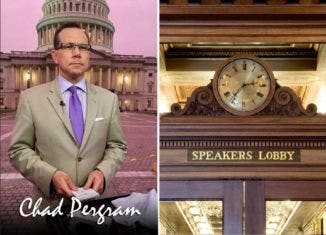The Perfect Storm
The Speaker’s Lobby: The Perfect Storm
By: Chad Pergram, FOX News
04 April 2009
There was a perfect storm in Washington last week.
It was the confluence of the health care reform bill, earmarks, wavering lawmakers, a respected Congressional watchdog group, misplaced decimal points and journalists searching for a story.
And this perfect storm demonstrates how a simple mistake and a healthy skepticism about lawmakers’ motives can go awry.
On the heels of the Democrats’ legislative win, the non-partisan Sunlight Foundation intimated there may have been a tradeoff for votes. Sunlight released a report that linked the earmark requests of pivotal lawmakers to their support for the bill.
“A day after Rep. Bart Stupak (D-MI) and ten other House members compromised on their pro-life position to deliver the necessary yes-votes to pass health care reform, the ‘Stupak 11’ released their fiscal year 2011 earmark requests, totaling more than $4.7 billion. This is an average of $429 million worth of earmark requests for each lawmaker,” Sunlight said in a statement. “Leadership can use granting of earmark requests as a way to get their fellow lawmakers to vote their way.”
A few days later, Sunlight issued a lengthy correction and clarifications to its story.
“The spreadsheet used to inform this blog entry contained four major errors in its data, causing Sunlight’s Reporting Group to overstate the amount of earmark requests by a few members by a factor of ten,” Sunlight said. “Further, the post implies that the requests are directly connected to the votes of 11 members of Congress on health care reform. Given the amount of information currently available on these members’ earmark requests, it is simply not possible to correlate that data.”
OMG.
First of all, a big hat tip to Sunlight. There are plenty of organizations who make allegations, are proven wrong and then never come clean. And anyone can make a mistake. But the best question to ask is how Sunlight’s errors got swept into a series of news stories and radiated throughout the blogosphere.
It was the perfect storm.
Capitol Hill buzzed in the hours leading up to the health care reform vote. It was clear they finally locked down the votes. But reporters and lobbyists chattered about what some pro-life Democrats, may receive in exchange for their vote. A public works project? A plum committee assignment? An infusion of campaign cash?
This is how the game is played.
The health care reform bill is a legacy vote. In fact, the health legislation and the bailout bill of 2008 are probably the two biggest votes taken by Congress in the past 40 years. And in the days prior to the vote, it was clear the House Democratic leadership didn’t have enough lawmakers lined up to approve the package. So it’s natural that journalists would start scouring for potential “deals” that may have been struck in exchange for these lawmakers to back the legislation. In fact in its correction, Sunlight’s Bill Allison and Anu Narayanswamy asserted that they “set out to look at how leadership–of both parties–persuades rank and file members to vote their way.”
The other problem is that the word “earmark” is galvanizing. Reporting on earmarks is easy pickings for journalists. Earmarks appear sleazy to the public. Even if they account for a fraction of the federal budget.
Sunlight suggested hat Congressional leaders Velcroed together the health care vote and the earmark requests. But the House Appropriations Committee sets up a calendar months in advance that spells out the deadline for lawmakers to turn in their earmark requests. In what one person declared “an unfortunate calendar coincidence,” the deadline just happened to be in synch with the health care vote. Never mind that the Democratic leadership had no idea when it could actually put the legislation on the floor for a vote.
“We implied that the requests and the vote were directly connected; we were wrong to–the requests are just one part of a process we are trying to follow,” wrote Allison and Narayanswamy on Sunlight’s website.
An additional problem is that these are just earmark requests. A determination of who gets what won’t come until the appropriations bills are finalized over the summer. Plus, earmark requests just don’t come in overnight. Community groups, local governments, law enforcement agencies, universities and highway departments work for months to prepare earmark requests and send them to Washington. Then their lawmakers sift through the requests to decide which ones they want to sponsor. It’s up to the House and Senate Appropriations Committees to then approve or deny the lawmakers’ requests.
In other words, you can ask for anything. But you rarely get everything.
In particular, Sunlight said it inadvertently ballooned earmark requests made by Reps. Charlie Wilson (D-OH), Steve Driehaus (D-OH) and Kathy Dahlkemper (D-PA). For instance, Driehaus asked for $33.22 million in earmarks. Sunlight’s clerical error bloated Driehaus’s request to $333.22 million.
There’s also another way to evaluate earmark requests.
Wilson received 197 earmark requests from constituents last year. This year he received 238 requests. Wilson’s spokeswoman, Hillary Wicai Viers concedes that’s a 21 percent increase over the last cycle. But Wilson represents eastern Ohio, home to some of the worst economic conditions in the state. Thus, Wicai Viers indicates it’s only natural for Wilson’s people to ask for more.
“If Mr. Wilson was worried about how something looked and didn’t submit any requests just for appearances, that wouldn’t be serving his district very well,” she said. “His district has needs.”
Regardless of the “appearance” error and the “decimal” mistake, there’s another potential matter: should Sunlight have even lumped these 11 lawmakers together in the first place?
In its initial release, Sunlight targeted 11 Democrats because of their anti-abortion positions and their concerns about whether the legislation could fund some abortions with tax dollars.
“The eleven members were the focus of high-level pressure by House Speaker Nancy Pelosi and other top Democrats because they threatened to vote against the health care reform bill, which passed the House on Sunday, March 21, by a seven-vote margin,” said Sunlight before the correction.
But Wicai Viers argues that Wilson’s was never part of that group to start with.
“Who the original Stupak group were was a matter of huge speculation,” she said. Wicai Viers indicated that her boss was fine with the anti-abortion provisions already and wasn’t seeking something stronger as Stupak was.
But a bigger issue remains: the responsibility of news organizations in reporting this story.
Dozens of journalists pounced on Sunlight’s study. Dissecting the health care legislation and why reluctant lawmakers suddenly voted yes to propel the measure to victory was a juicy item. Plus, Sunlight possesses a solid, trustworthy reputation as an organization that scrutinizes the intersection of money and politics. But in this case, reporters perpetuated Sunlight’s initial pronouncement, although it now concedes problems with the premise and the figures. And they’ve now granted those errors eternal life in the blogosphere.
No journalist wants to get it wrong. Sunlight is typically credible. But bad information and dubious context can burn even the best reporter. Sources can all botch things, whether it be the Sunlight Foundation, or those you meet wearing trench coats in an Arlington, VA parking garage.
The only way to avoid this is for the reporters to crunch the numbers themselves. And that’s rarely possible.
Regardless, once it’s out there, no one can stuff the genie back in the bottle.
“The blogosphere picked it up immediately,” said Wicai Viers as soon as scribes began writing about Wilson. “I started getting these Google alerts. It was bing, bing, bing, bing.”
“All of a sudden, you have this big mess to clean up,” said Tim Mulvey, a spokesman for Steve Driehaus. He faulted Sunlight’s premise that lawmakers may have traded their votes for earmarks.
“That’s a wild and weighty accusation,” Mulvey said. “That’s tantamount to accusing a Member of Congress of accepting bribes.”
Wicai Viers fired off a letter to Sunlight, despite the mea culpa.
“Why let the facts get in the way of a good story as long as it promotes your agenda?” she asked.
But Mulvey was more generous to Sunlight.
“Don’t let this be a knock on the Sunlight Foundation,” he said. “I think this was a good faith mistake.”
Citing the holiday weekend, Sunlight spokeswoman said it was unable to make anyone available to comment for this story.
In the end, this entire affair was a perfect storm. Journalists wanted to study the mechanics that achieved a major legislative victory. A watchdog organization tried to dissect the vote as well. And lawmakers were just doing what they always do: vote and earmark.
Before the big vote, I warned my colleagues to be cautious of jumping to conclusions about why certain lawmakers voted which way. Lawmakers who were on the fence and then voted yes deserve scrutiny. But not all of their decisions are nefarious.
In the end, Sunlight was trying to uphold its mission of demanding Congressional accountability. The press was trying, too. But there’s a danger here. Perhaps some lawmakers did strike deals. Let’s just hope now that no one is too gun shy to report them.
– Chad Pergram covers Congress for FOX News. He’s won an Edward R. Murrow Award and the Joan Barone Award for his reporting on Capitol Hill.
– The Speaker’s Lobby refers to a long, ornate hallway that runs behind the dais of the House chamber. Lawmakers, journalists and aides often confer there during votes.

